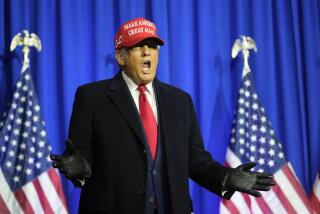Trump threatens to slap tariffs on an additional $200 billion in Chinese goods, raising trade tensions

President Trump, moving to amp up pressure on China to make trade concessions, threatened late Monday to impose tariffs on an additional $200 billion in Chinese imports and to double that amount if Beijing retaliates with countermeasures.
Trump’s announcement marks the latest escalation of a brewing trade conflict with China. It comes after the White House on Friday detailed plans to slap 25% tariffs on $50 billion in goods imported from China, most of that to take effect July 6.
The news sparked widespread fears that the two largest economies were heading inexorably to a trade war that would have damaging ripple effects across the globe. Stocks plunged overnight in Asia, with indexes in Shanghai falling almost 4% and in Hong Kong dropping nearly 3%. U.S. stock futures were pointing to a sharply lower opening.
The reaction from Beijing was swift. China’s Ministry of Commerce said that preparing tariffs on $200 billion more of the country’s exports to the United States was tantamount to “extreme pressure and blackmail.”
“If the U.S. side becomes irrational and issues [tariff] lists, China will have to adopt comprehensive measures both in proper quantity and quality to make a strong counter-measure,” a ministry spokesperson said.
Beijing had similarly responded quickly Friday to the administration’s announcement of the initial round of tariffs, by saying it would match them dollar-for-dollar by applying similar duties on American farm products, cars and other merchandise, also starting July 6.
So far, Trump’s trade battle with China has been mostly threats, and businesses and other parties have been hoping that the two sides will return to the negotiating table. But three bargaining sessions have not yielded a deal to quell tensions. With no word on future talks and both sides not wanting to appear weak, worries are rising that a hardening of positions could lead to a full-blown trade war.
Chinese and American analysts closely following the trade dispute said they now expect the initial tariffs and counter-tariffs on July 6 to take effect. “We have many reasons to be pessimistic about a trade war,” said Wang Yong, deputy director at Peking University’s Center for New Structural Economics.
Trump, in his statement Monday, said that Beijing’s earlier threat to retaliate, rather than change trade practices to which the United States has objected, showed that “China clearly indicates its determination to keep the United States at a permanent and unfair disadvantage, which is reflected in our massive $376 billion trade imbalance in goods. This is unacceptable.”
The president said that he had directed his trade advisors to identify an additional $200 billion worth of Chinese goods to be assessed tariffs of 10%. These would be implemented if China “refuses to change its practices,” Trump said, warning that if Beijing responds by upping duties on additional U.S. imports, he would pursue tariffs on another $200 billion in Chinese products.
“The trade relationship between the United States and China must be much more equitable,” Trump said.
Even before Beijing responded on what was Tuesday morning in China, its official news agency posted a commentary Monday accusing Washington of reneging on an understanding between the two sides that the U.S. would hold off on tariffs after China pledged to buy more American goods.
“China does not want to fight a trade war,” the commentary said. “However, in the face of the short-sighted behavior from the United States, China has to give a strong comeback, firmly defend the interests of the country and the people, and resolutely safeguard economic globalization and the multilateral trading system.”
Trump had previously threatened to increase tariffs to as much as $150 billion in Chinese goods. By tripling the amount to potentially $450 billion, he would hit about 90% of all Chinese imports to the U.S.
China last year exported almost $506 billion of goods to the United States, and imported about $130 billion from America, according to the U.S. Census Bureau.
Trump’s initial tariffs on $50 billion in Chinese goods were in response to U.S. allegations of China’s theft of intellectual property and its policies forcing American companies to hand over technology in return for access to China’s vast market — a longstanding complaint through multiple administrations.
Trump said Monday that “China apparently has no intention of changing its unfair practices related to the acquisition of American intellectual property and technology.”
The first tranche of tariffs are set to take effect July 6 on 818 types of Chinese goods valued at about $34 billion. The U.S. Trade Representative office is compiling a list of an additional $16 billion worth of products that would be assessed 25% duties at a later date.
“Further action must be taken to encourage China to change its unfair practices, open its market to United States goods, and accept a more balanced trade relationship with the United States,” Trump said.
The products slated for U.S. tariffs include a variety of tech-related products and parts, and are meant to slow China’s advancement in cutting-edge technologies and industries. The U.S. goods that China has targeted for duties include many farm goods such as soybeans, hitting farm states that are home to many Trump supporters.
Trump’s latest tariffs statement will likely be met with apprehension from Republicans in Congress and U.S. business interests, who have cautioned the administration about the potential harm to American consumers, farmers and companies.
The National Retail Federation’s president, Matthew Shay, called the president’s latest tariff threat a “reckless escalation” and urged Congress to exert authority on trade policy.
Derek Scissors, a China expert at the conservative-leaning American Enterprise Institute, said he wasn’t surprised by Trump’s action to up the ante. When Beijing said it was going to match the $50 billion in tariffs, he said, it “can only be seen as treating the Trump administration as weak.”
“President Trump has to show that he’s trying to reduce the trade deficit,” Scissors said, alluding to Trump’s repeated promises to his supporters that he would clamp down on China’s trade and slash the deficit.
China imports only one-fourth as much as it sends to the U.S. in goods, so Beijing would not be able to keep retaliating dollar for dollar.
However, American businesses have invested far more in China than China has in the United States, and Beijing could retaliate against U.S. firms operating in China — by delaying business transactions, for example, increasing inspections on imports, or applying domestic laws more strictly.
Follow me at @dleelatimes
UPDATES:
4:35 a.m.: This article was updated with additional reaction, including from markets, and analysis.
8:40 p.m.: This article was updated with reaction from China and U.S. groups and interests.
This article was originally published at 7:45 p.m.






